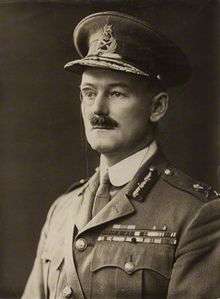John Shea (Indian Army officer)
| Sir John Shea | |
|---|---|
 General Sir John Shea | |
| Born | 1869 |
| Died | 1966 |
| Allegiance |
|
| Service/branch |
|
| Years of service | 1888–1932 |
| Rank | General |
| Commands held |
151st Brigade 30th Division 60th Division 3rd (Indian) Division Central Provinces District Eastern Command, India |
| Battles/wars | |
| Awards | |
General Sir John Stuart Mackenzie Shea GCB, KCMG, DSO (1869–1966) was a British officer in the Indian Army.
Military career
Educated at Sedbergh School and the Royal Military Academy Sandhurst,[1] Shea was commissioned into the Royal Irish Regiment in 1888.[2] He transferred to the Indian Army and was posted to the 15th Bengal Lancers in 1891.[2] He saw action with the Chitral Expedition in 1895 and then during the Second Boer War.[2] During the latter conflict he was awarded the Distinguished Service Order for leading 200 South Australians in a night attack on Commandant Jan Smuts's laager.[3] He became an Instructor at the Staff College, Quetta in 1906.[2]
Shea served in World War I initially as a General Staff Officer first with the British Expeditionary Force and then with 6th Division.[2] He became Commander of 151st Brigade in 1915, General Officer Commanding 30th Division in 1916 and General Officer Commanding 60th (2/2nd London) Division in Palestine in 1917.[2] He commanded the 60th Division at the Battle of Mughar Ridge in November 1917, at the Battle of Jerusalem in December 1917 and at the First Battle of Amman in March 1918.[4] On 9 December 1917 he received the keys of the city of Jerusalem, an act symbolizing its surrender by the mayor Hussein al-Husayni, after many other generals refused to take this responsibility.[5]
After the War he became a Corps Commander in Palestine in 1918, General Officer Commanding 3rd (Indian) Division in 1919 and General Officer Commanding Central Provinces District in India in 1921.[2] He went on to be Adjutant-General, India in 1924 and General Officer Commanding-in-Chief, Eastern Command, India in 1928 before retiring in 1932.[2]
References
- ↑ Anglo-Boer War
- 1 2 3 4 5 6 7 8 Liddell Hart Centre for Military Archives
- ↑ Desert Column
- ↑ Baker, Chris. "British Divisions of 1914–1918". The Long Long Trail.
- ↑ Jacobson, Abigail. From Empire To Empire. Syracuse University Press. p. 130.
| Military offices | ||
|---|---|---|
| Preceded by Sir George Barrow |
Adjutant-General, India 1924–1928 |
Succeeded by Sir Robert Cassels |
| Preceded by Sir George Barrow |
GOC-in-C, Eastern Command, India 1928–1932 |
Succeeded by Sir Norman MacMullen |